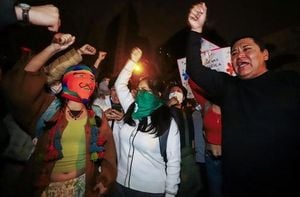The Toronto International Film Festival (TIFF), long celebrated as a cornerstone of Canada’s cultural landscape, has found itself thrust into the heart of an international controversy this year. What began as a celebration of cinematic achievement has transformed, almost overnight, into a flashpoint for debates about artistic freedom, political legitimacy, and the responsibilities of cultural institutions in times of conflict.
TIFF has always prided itself on being a gathering place for filmmakers, artists, and audiences from around the world. Each September, Toronto’s streets fill with moviegoers hoping to catch a glimpse of celebrities or discover the next great film. But this year, the festival’s usual glamour has been overshadowed by an intense dispute surrounding its programming choices, particularly those related to the Israeli-Palestinian conflict.
At the center of the storm is “The Road Between Us: The Ultimate Rescue,” a documentary directed by Barry Avrich. The film chronicles the heroism of Noam Tibon, who risked everything to save lives—including those of his own family—during the Hamas-led massacre of October 7, 2023. Initially, TIFF approved the screening, recognizing the film’s powerful depiction of courage in the face of terror. But soon after, the festival abruptly cancelled its showing, citing the inclusion of footage recorded by Hamas during their attacks. Because Hamas had not granted permission for these videos to be used, TIFF deemed the film’s content illegitimate.
The decision set off a firestorm. Critics accused the festival of caving to political pressure and, more troublingly, of undermining the legitimacy of Jewish narratives in the public sphere. The implication, some argued, was that Jewish pain and Israeli suffering were being dismissed or erased. As one observer noted, “Just underneath the surface, the implication was that Israel is illegitimate, and that Jewish pain is not really legitimate either. That’s how gatekeeping works.”
The backlash was swift and fierce. After a wave of public outcry—both from within Canada and abroad—TIFF reversed its decision, reinstating the screening of Avrich’s documentary. The reversal did little to quell the broader debate, however. Instead, it illuminated the deep divisions and sensitivities that continue to swirl around representations of the Israeli-Palestinian conflict in art and media.
This year’s TIFF has not only been defined by the controversy over “The Road Between Us,” but has also featured several other films exploring the complexities of life in the region. Documentaries and narratives such as “The Land of Milk and Honey” and “A Gaza Weekend” have put a spotlight on the human experience within conflict zones. While these films aim to foster empathy and understanding, their ties to political movements—particularly those connected to Hamas—have sparked heated debates among audiences, critics, and community leaders.
Some argue that screening films which include or reference Hamas risks normalizing or even endorsing violence and extremism. According to critics, “screening such films could inadvertently normalize or endorse violence and extremism.” Others counter that cinema must remain a space for all narratives, including those of oppressed or marginalized groups, and that suppressing certain stories only serves to deepen misunderstandings and perpetuate cycles of conflict.
TIFF’s organizers have found themselves walking a tightrope. In a recent press conference, a festival spokesperson emphasized, “Our goal is to foster discussion and understanding, even when confrontational topics are covered.” The festival has reached out to community leaders, activists, and industry professionals in an effort to clarify its stance and ensure that TIFF remains a safe space for dialogue. In addition, the festival has organized panels and discussions specifically designed to address the implications of screening politically charged films during such a volatile period.
The controversy has also reignited longstanding debates about the role of Jewish filmmakers and narratives in Hollywood and beyond. Historically, Jews turned to the film industry at a time when other doors were closed to them, and their contributions became central to the development of cinematic culture in North America. Films that grappled with the Holocaust, Jewish identity, and the ongoing challenges facing Israel have won Oscars and shaped public consciousness. Yet, as one commentator observed, “We were told, in whispers and then in plain voice, enough already. No more Holocaust films.” The tension between telling essential stories and the accusation of overrepresentation remains a live wire in cultural circles.
Against this backdrop, the recent spike in antisemitism has cast an even longer shadow over the proceedings. At the Anti-Defamation League’s “Never is Now” conference in New York this past March, actor David Schwimmer addressed the entertainment industry directly, urging his peers to take a public stand. His words resonated: “So many have chosen not to say anything publicly at all. And if I can say something directly to them: I really wish you would.” Schwimmer’s call for courage in the face of rising hatred underscores the stakes of the current moment, not just for TIFF but for cultural institutions everywhere.
The intersection of art and politics is always fraught, but the events at TIFF this year have brought those tensions into especially sharp relief. The festival’s leadership has reiterated its mission to promote a diverse range of voices and to use cinema as a lens through which society can grapple with difficult, sometimes painful, realities. Yet, as the debates over legitimacy, representation, and responsibility continue, it’s clear that the path forward will be anything but simple.
For many, the lessons of this year’s TIFF go beyond the fate of a single film or even a single festival. They point to the enduring power of art to shape perceptions, challenge prejudices, and spark meaningful conversation—even, or perhaps especially, when the subject matter is contentious. As one festival attendee put it, “We need films about October 7, and films about 1943. We need films that show us these horrors, and also show us the ethical complexity of Europe as well as Gaza.”
As TIFF moves forward, it finds itself at a crossroads: caught between the imperative to bear witness and the pressure to avoid controversy, between the desire to include all voices and the need to guard against the normalization of violence. The choices made in Toronto this year will likely reverberate far beyond Canada’s borders, shaping how future festivals—and indeed, the wider world—navigate the complicated terrain where art, politics, and identity collide.
One thing is certain: the debates sparked at TIFF this year will not fade quickly. They serve as a powerful reminder that the stories we tell, and the ways we choose to tell them, matter deeply—sometimes more than we realize.



